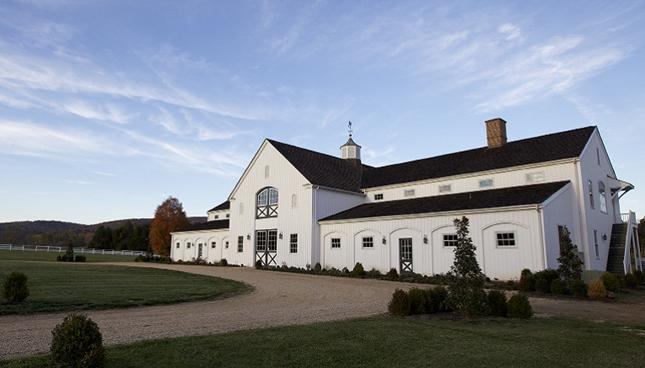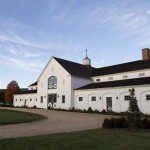The Apple of Charlottesville’s Eye
By • July 26, 2011 0 2712

In 1998, a great barn was built in Keswick, VA on the Castle Hill estate, just a stone’s throw from Charlottesville and Monticello. Located on a 600-acre plot of rolling, endless hills, the barn was designed to accommodate cattle auctions for the surrounding ranchers. Like much of Keswick, the land is undeveloped and still entrenched in the natural beauty of Virginia, with a prominent view of the Southwest Mountains.
When architect and landscape designer John Rhett saw the abandoned barn in 2008, with it’s 8,000 square feet of open space and 25-foot ceilings, he had other plans for it.
He became involved with the current owner of the property fixing up the house and beautifying the grounds, but it was clear that there was much more to be done, especially to the barn. When Rhett was approached about putting a vineyard on the property and converting the barn to a winery, his answer was a bit more interesting than a simple yes or no. “I prefer trees to vines,” he said. “I said, why don’t we think of planting an orchard and starting a cidery.” And so the Barn at Castle Cider, a cidery and the area’s newest event space, came to be.
The barn has been completely transformed since Rhett, now General Manager, began renovations. At one end of the barn is a beautiful fieldstone fireplace with white oak paneling, where ranchers used to mingle before the auction. “That’s our tasting room,” says Rhett, who is building a limestone bar and small kitchen into the area. The tasting room is designed fittingly for cocktail parties, rehearsal dinners and other small gatherings. The library, located directly above the tasting room, has its own working fireplace and an upper porch with a breathtaking view of the outlying meadow and mountain range.
“The other end of the barn is where they used to wash down the cattle,” says Rhett. “We’re going to convert that room to our tank room for the cider.”
In the center of the barn, with the cavernous open space, Rhett is building a stage and a loft. The loft connects to the library by a catwalk, and each end of the loft has wide doors that open to views of the estate.
Rhett then designed terraced lawns by the barn, which sit above a stream and small lake. It is almost too easy to envision a wedding ceremony by the water, with the great white barn in the background, surrounded by mountains and apple trees.
Beyond its rustic beauty, the Castle Hill estate holds historical significance to the area, and Rhett did not want it lost to the public. “There’s a lot of history here,” he says. “This place was built in 1764.” Listed on the National Register of Historic Places, Castle Hill was originally the home of Colonel Thomas Walker, Thomas Jefferson’s guardian and mentor.
The land’s local historical significance, and a mission to build the community through the making and partaking of cider, was much of Rhett’s inspiration for designing the barn as a public and private event space.
The rich history of Castle Hill bleeds into the apple orchard Rhett planted in the fall of 2009. Made up of 600 trees with 28 different types of apples, its most prized variety is a largely forgotten breed named the Albemarle Pippin. “It’s an apple that became a favorite of Queen Victoria’s,” says Rhett. “She was given a basket of them, and she liked them so much that she removed the tariff from the apple just so it was cheaper to import them.”
The Albemarle Pippin got here by the hands of George Washington himself. Originally from New York, Washington gave a cutting to Colonel Walker (the very same Colonel Walker from before), who planted it in Albemarle County. “We’re bringing it all back to Castle Hill by planting them here,” says Rhett.
The apple varieties will all be fermented individually to retain their unique flavors, and then blended to create different hard ciders. Rhett has gone back to the origins of cider production with his fermentation process. He has brought in amphoras from the Caucasus Mountains in the country of Georgia, called kvevri. They are lined with beeswax and buried in the cool earth, wherein the cider is poured and the fermentation works it’s magic.
“The cider never touches modern material to impart any flavors,” says Rhett, who dislikes the metallic taste he finds in wine fermented in steel tanks. “There’s no one really in the world making cider this way anymore.”
The kvevri are buried alongside the barn, protected by a large overhang. Fifty feet away, the very same cider will soon be served at the bar in the tasting room. “You walk into the barn and you smell apples,” says Rhett. “It’s really nice.”
The Barn at Castle Hill is a warm and stunning host for any affair, a space that begs to be filled with life. Its high walls echo with the expectations of history experienced, and history waiting to be made. The barn has been hosting fundraisers and events, and they have their first wedding booked for June. I imagine this place will be filling up fast. The next time you visit Charlottesville, stop by the big white barn, have a glass of cider and see for yourself.
For more information, visit Castle Hill Cider online.
- The Barn at Castle Hill Cider, a cavernous barn on a beautiful estate in Keswick, VA, is a two-in-one cidery and events space.





